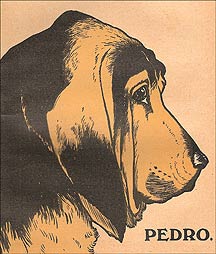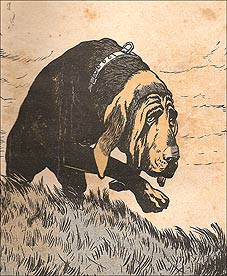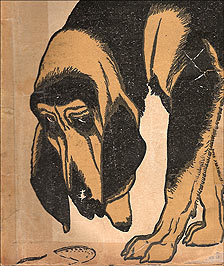THE END OF THE TRAIL
A TRIBUTE TO PEDRO
by Walter Webb

'Every Dog Has His Day' is a good old saying, and in the case of Pedro, famous bloodhound and canine ally of the equally famous Sexton Blake, the description is particularly apt, for without doubt, the noble fellow has had his day. Many a trail has Pedro followed in the past, in all parts of the world, in the company of the two masters he has served so faithfully and unfailingly. Now he has reached the end of the longest trail of all — his own.
Whether or not this generation of Blake readers want Pedro featured in the present day exploits of the Baker Street pair is doubtful; what is abundantly clear is that the Blake authors of today have no intention of giving further recognition to what they obviously regard as a spent force. If this is the light in which they look on things, it might be pointed out to them that far from being out-of-date, the bloodhound is still of inestimable value to the police in the tracking of criminals, and will continue to be used with telling effect while crime exists.
It was W. Murray Graydon who brought Pedro into the world; the same author who a little earlier, just after Tinker's arrival, had established Sexton Blake at Baker Street and then introduced Mrs. Bardell as housekeeper.
It was in the case known as The Dog Detective (UNION JACK issue 100, published 9 September, 1905), that we heard of Pedro for the first time, and he was described then as being 'liver-coloured mottled, with spots of rusty yellow, of enormous size, massive-limbed and pendulous-jowled'. Pedro's original owner was a man named Rafael Calderon, who, on going abroad and not wishing to take the bloodhound with him, made Blake a present of the sagacious fellow, in appreciation of the services the criminologist rendered him during the case just mentioned.
From that day Pedro became as much a part of the stories as Sexton Blake and Tinker themselves, and not a week was allowed to slip by but that the bloodhound was featured, be it only in a small way. Even when Blake's investigations necessitated him going abroad there was no thought in his mind of leaving Pedro at home; Pedro went and thus must have become the most widely-travelled dog in the histroy of the canine world!
Pedro proved his fearlessness and courage on many occasions, and there was nothing born of four legs who could make him quail. In Africa, he met unflinchingly the attack of a leopard in an encounter which ended abruptly when, locked in close embrace, they toppled off a tree trunk into a surging river — perhaps fortunately for the hound; then there was another occasion when, with Sexton Blake helpless on the ground, Pedro stood across his master and bayed defiance at a lion which was about to spring. The bloodhound kept the King of the Jungle sufficiently long at bay for Tinker to take aim with his rifle and shoot him dead.
Pedro's love for children is well-known, and in a case published in 1908 he was instrumental in saving the life of a little girl, when a panther which had escaped from a menagerie threatened her life. What followed was a fight to the death between the bloodhound and his formidable adversary, but Pedro fortunately managed to obtain an early grip with his strong teeth on the panther's throat and that spelt 'finis' for him.
A later adventure described how, when lost in the forests of Brazil, Tinker was stalked by a Jaguar, whose intentions were so obvious that Blake's youthful assistant gave himself up for lost. But Pedro was at hand, and instead of becoming a victim of the jaguar's vicious teeth, it was the jungle beast who became the object of
Pedro's. This incident was described more fully in the story entitled Sexton Blake — Avtiator (UNION JACK issue 317 published 6 November, 1909), and was one of those extremely rare narratives of Sexton Blake written by that grand old-timer, D. H. Parry.
Thereafter, the exhilaration of the chase often proved too much for Pedro, and back home in his native London the urge to dash after stray cats and small dogs sometimes proved too strong for him. On those occasions his departure from dignity would oft incur a wrathful rebuke from the older master, though to be nullified somewhat by a sympathetic and understanding grin of quiet enjoyment from the younger.
 Pedro would have you know, however, that these and similar incidents only occurred during his younger and impressionable days; with the passing of the years came a greater sense of his responsibilities, a graver, more
sober outlook on life, so that he came to look upon the various types which made up the feline world, and the many pedigrees of his own four-footed clan, with lofty disdain, prompted not by any feelings of snobbishness or exaggerated ideas his own importance, but simply because his beloved older master expected him to do so.
Pedro would have you know, however, that these and similar incidents only occurred during his younger and impressionable days; with the passing of the years came a greater sense of his responsibilities, a graver, more
sober outlook on life, so that he came to look upon the various types which made up the feline world, and the many pedigrees of his own four-footed clan, with lofty disdain, prompted not by any feelings of snobbishness or exaggerated ideas his own importance, but simply because his beloved older master expected him to do so.
In his heyday Pedro played the leading role in a number of the early cases of Sexton Blake, and one outstanding example was the occasion when wholesale smuggling was taking place on the French and Belgian frontiers. The intervention of the famous bloodhound resulted in the rounding-up of the smugglers, and Sexton Blake honoured his noble ally by briefing the affair in his case-book as Pedro's Trail. Beverley Kent used both title and ingredients for his detailed account of the case which was published in the UNION JACK dated 14 March, 1908.
From the time of his first appearance to the outbreak of the first world war, Pedro was well to the fore; then from 1914 his star began to wane, and his appearances began to get fewer and farer between, until, by the twenties, he was making only occasional appearances in the stories. Only W. Murray Graydon and Allan Blair in the SEXTON BLAKE LIBRARY featured Pedro with any degree of consistency, for amongst the newer and younger writers the bloodhound seemed right out of favour, and in some instances certain authors never once referred to him at all.
Gwyn Evans put Pedro right back in the limelight when he described in UNION JACK issues 1,179 and 1,180 how Sexton Blake smashed the schemes of a gang of dope traffickers. Most of the action in this case occured in the Channel Islands, and no doubt when he jumped ashore at St. Peter Port, the capital of Guernsey, Pedro had no inkling that this was to be the scene of his greatest case. A point of particular interest about Guernsey is the fact that Victor Hugo was an exile there when he wrote Toilers of the Sea.
Blake tracked down the leader of the drug traffickers to the island of Hathou, a small dreary spot beyond Herm, but both he and Tinker were made prisoners by the gang, and it was left to Pedro to foil the schemes of the evil-doers.
Working on behalf of his Government, Blake was in possession of a secret which if divulged would smash the chancelleries of Europe and menace the world with another war, but by the injection of a truth-compelling drug, the gang leader, unmasked by the detective as an eminent M.P., learned the secret.
Blake and Tinker were imprisoned in an old monk's house from which escape was impossible, but when his master sent a piercing whistle out across the lonely desolate wastes to him, Pedro was not found wanting. Although the prison was guarded by a wolf-dog named Satan, this did not deter the bloodhound, and after a bitter battle in which Satan was killed, Pedro submitted to having a handkerchief containing a written message for help tied round his neck by his master through the bars of his cell. When he was told to go home to Baker Street the old fellow was left wondering how on earth his master expected him to get across the long stretch of water between him and home. When he saw the steam-yacht belonging to the leader of the gang lying at anchor, Pedro got a brilliant idea and stowed himself away on the vessel. He was subsequently discovered by the ship's cook, a Chinaman, knocked out, muzzled, and sold to an Egyptian restaurant owner. When the place was raided by police led by Inspector Coutts, Pedro was discovered, and acting on the information contained in the message around Pedro's neck another raid was made on the island of Hathou, in which the gang leader was killed. It was a triumphant ending to a difficult case, in which Pedro took chief honours.
If there was one time of the year which Pedro enjoyed more than any other, it was Christmas, for it was on those occasions that he met most of his human friends, under his own roof. Beneath the holly and mistletoe and the gaily-coloured bunting which adorned his master's sitting-room in the modest-fronted house in Baker Street, Pedro was wont to sprawl at his ease in front of a cracking log fire and enjoy the many caresses and hugs which were affectionately bestowed upon him by his master's numerous friends, men and women whose friendship he was proud to share.
 There would be Mr. Spearing of the Yard, stocky, fiery, short-tempered, but a faithful old ally; Sir Richard Losely, an old school-fellow of his master's, and a much-travelled man; Lobangu , chief of the Etbaia; the Hon. John Lawless, globe-trotter, and man of independent means; Dirk Dolland, suave, dapper, and one-time cracksman; Granite Grant, secret service agent, spare of speech but explosive of action; Splash Page, newspaper reporter and a human bloodhound in his quest for hot news; Ruff Hanson, tough American sleuth, whose habitual use of two trusty firearms, nicknamed Willy and Wally, did not altogether meet with Pedro's approval, for the old fellow had more than once been on the receiving end of the leaden objects they ejected with such damaging and often fatal effects. Then there was Waldo the Wonder-Man, who was something of puzzle to Pedro because sometimes his master would instruct him to track the fellow down whilst at others the pair would be quite friendly disposed to each other. It was all rather puzzling to a bloodhound whose only desire was to do his level best for the master who placed so much faith in him; but then, there was much about the human race that the canine intelligence could never understand, so Pedro never allowed his mind to dwell too deeply on such matters, and invariably dismissed them with an expressive whisk of the tail. The Hon. Eustace Cavendish was another well-remembered visitor who made an occasional Yuletide call, and despite the vacuous expression on his somewhat foolish features and the dandified air, Pedro was sufficiently an observer of human nature to know that this was only a cloak concealing a very keen intelligence.
There would be Mr. Spearing of the Yard, stocky, fiery, short-tempered, but a faithful old ally; Sir Richard Losely, an old school-fellow of his master's, and a much-travelled man; Lobangu , chief of the Etbaia; the Hon. John Lawless, globe-trotter, and man of independent means; Dirk Dolland, suave, dapper, and one-time cracksman; Granite Grant, secret service agent, spare of speech but explosive of action; Splash Page, newspaper reporter and a human bloodhound in his quest for hot news; Ruff Hanson, tough American sleuth, whose habitual use of two trusty firearms, nicknamed Willy and Wally, did not altogether meet with Pedro's approval, for the old fellow had more than once been on the receiving end of the leaden objects they ejected with such damaging and often fatal effects. Then there was Waldo the Wonder-Man, who was something of puzzle to Pedro because sometimes his master would instruct him to track the fellow down whilst at others the pair would be quite friendly disposed to each other. It was all rather puzzling to a bloodhound whose only desire was to do his level best for the master who placed so much faith in him; but then, there was much about the human race that the canine intelligence could never understand, so Pedro never allowed his mind to dwell too deeply on such matters, and invariably dismissed them with an expressive whisk of the tail. The Hon. Eustace Cavendish was another well-remembered visitor who made an occasional Yuletide call, and despite the vacuous expression on his somewhat foolish features and the dandified air, Pedro was sufficiently an observer of human nature to know that this was only a cloak concealing a very keen intelligence.
Amongst the ladies, Pedro had a very warm spot in his heart for Mademoiselle Yvonne, and had always entertained a secret hope that one day would find her installed as a permanent member of the Baker Street household. Even to a dog with half an eye, it was obvious that the older master had a very deep affection for the girl and that on her part it was reciprocated, so why on earth didn't the guv'nor pop the all important question? The older master had the right to make his own decisions, of course, but there were times when he — Pedro — really despaired of him!
Yes, those were the days, every hour of which was a happy one for the old fellow — but what of today? No longer does he see the friendly faces as of yore; there comes to him no caress of welcome from any of his old admirers; the affectionate slap on the flank, the gentle pull on his long ears by the white feminine hand of the beautiful girl for whose life the old fellow would have laid down his own, are just memories. Today, his masters see little of their Baker Street residence, and Pedro, yet another victim of the changing times, becomes one more has-been, so that we visualise him either chained up in his kennel at the rear of the house or wandering disconsolately about the kitchen quarters with Mrs. Bardell as his sole companion.
If permitted a glance through Sexton Blake's case-book for the year 1921, one would eventually come across details of a case in which Pedro played a not unimportant part. The title — The End of the Trail — is not without significance, for it could well be Pedro's epitaph.
© Walter Webb
